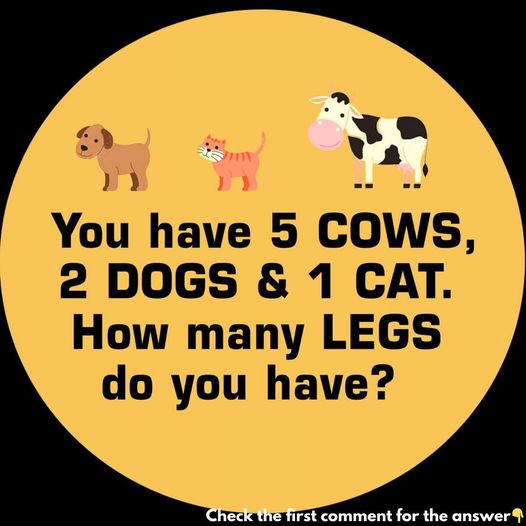In the world of puzzles and riddles, some questions are designed to lead you in the wrong direction. A perfect example is the seemingly simple question: “You have 5 cows, 2 dogs, and 1 cat. How many legs do you have?” On the surface, it looks like a straightforward math problem, but it’s actually a clever trick meant to deceive. Let’s break down this riddle and dive into the psychology behind deceptive questions.

Understanding the Trick: A Closer Look at the Riddle
When faced with this question, your first instinct might be to calculate the total number of legs for all the animals mentioned: cows, dogs, and cats. This is where the deception comes into play. By focusing on the animals, you miss the real subject of the question—you!
Let’s analyze the math first:
- Cows: Each cow has four legs. With 5 cows, you get 5×4 = 20 legs.
- Dogs: Each dog also has four legs. For 2 dogs, that’s 2×4 = 8 legs.
- Cats: One cat has four legs, adding 1×4 = 4 legs.
Adding all of these gives you a total of 20+8+4 = 32 legs. But here’s the catch: the question isn’t asking about the animals’ legs. It’s asking, “How many legs do YOU have?”
The Real Answer: Two Legs
The correct answer is much simpler than you might think. As a human, you typically have two legs. The mention of cows, dogs, and cats is simply a distraction—an attempt to lead you away from the true answer. It’s a classic example of a “red herring” in riddles, where irrelevant details are thrown in to mislead you.
This riddle demonstrates how easily we can be tricked by unnecessary information. Humans are naturally drawn to the most obvious details, especially when they think a question involves math or logic. This tendency often causes us to overthink and miss the simple, correct answer.
Why Deceptive Questions Work: The Psychology Behind It
Deceptive questions like this one succeed because they exploit how we process information. When presented with a list of animals and a question about legs, our brains automatically connect the two, making us count the animals’ legs instead of thinking about the actual question. This shows how context can shape our thought process and steer us in the wrong direction.
Cognitive Biases That Lead Us Astray
Several cognitive biases contribute to why we fall for deceptive riddles like this:
- Anchoring Bias: This occurs when we place too much importance on the first piece of information we see—in this case, the animals and their legs.
- Confirmation Bias: Once we start counting the animals’ legs, we tend to stick with that approach and ignore clues pointing to the actual answer.
- Overthinking: Our minds often make simple questions more complicated, leading us away from the easy solution.
How to Outsmart Deceptive Questions
To avoid being tricked by riddles like this, here are a few tips:
- Read the Question Carefully: Focus on what’s really being asked, not on the irrelevant details.
- Ignore the Distractions: Recognize when extra information is designed to throw you off and ask yourself whether it’s necessary to solve the problem.
- Simplify the Problem: Break it down to its core components. If the question is about you, concentrate on yourself and ignore the other distractions.
- Practice Critical Thinking: Engage in puzzles, brain games, and mindfulness exercises to sharpen your ability to spot tricks.
Conclusion: Mastering the Art of Deceptive Questioning
The riddle about how many legs you have is a great example of how easily we can be misled by irrelevant details. The key to solving such riddles is to focus on the true question and avoid the distractions. By understanding the psychology behind deceptive questioning, you can improve your critical thinking skills and avoid falling for these clever tricks.
Next time you encounter a riddle like this, remember: the simplest answer is often the correct one.





